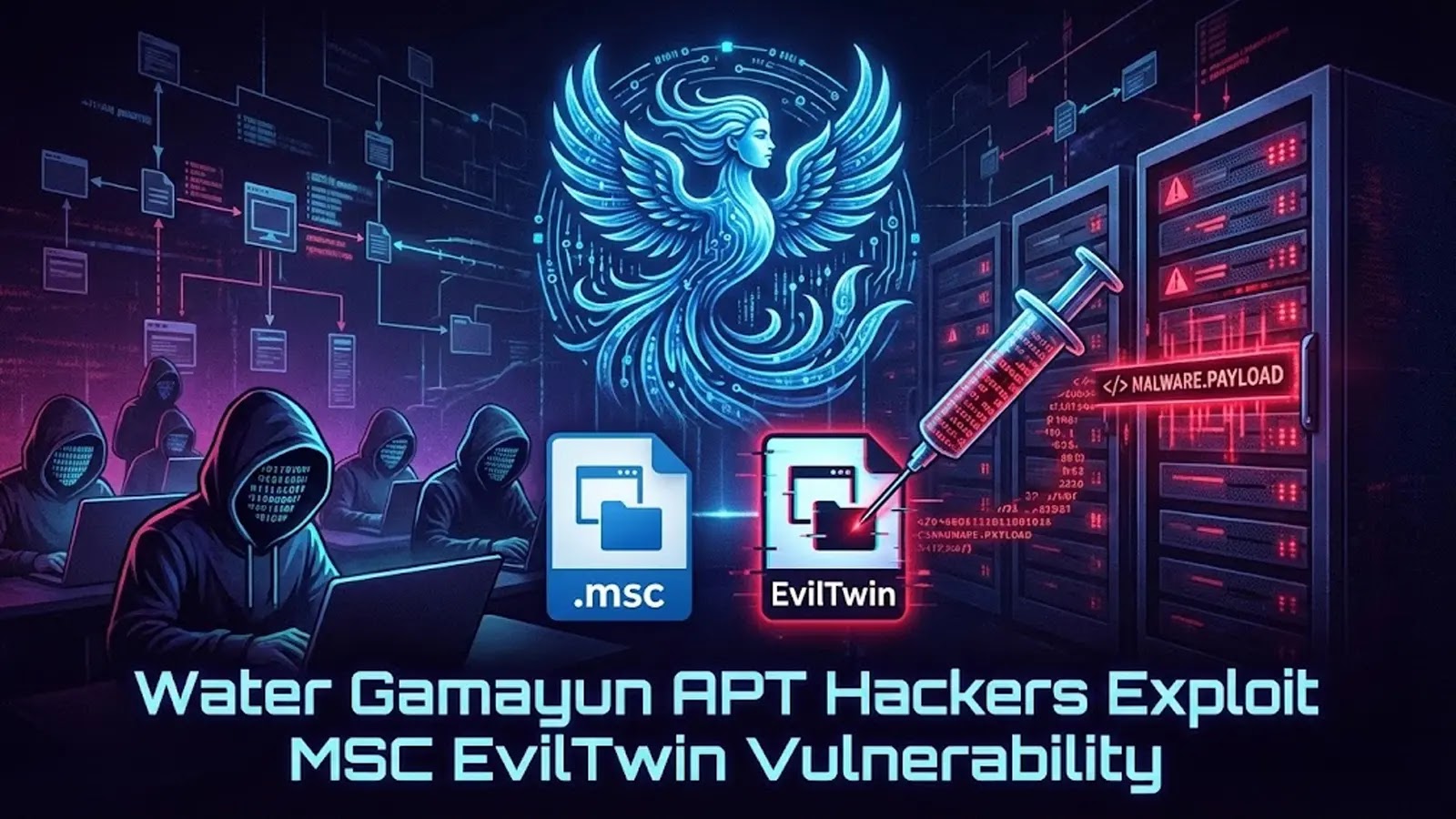
Water Gamayun APT Hackers Exploit MSC EvilTwin Vulnerability to Inject Malicious Code
The digital espionage landscape is under constant siege, with sophisticated threat actors continually refining their tactics. A disturbing new development has emerged with the highly persistent group known as Water Gamayun. These adversaries have significantly escalated their offensive capabilities by actively exploiting a critical vulnerability, dubbed MSC EvilTwin (CVE-2025-26633), within Windows systems. This latest campaign represents a formidable threat to enterprise and government organizations, driven by a clear objective: exfiltrate sensitive data, compromise credentials, and establish enduring access to targeted networks.
The emergence of this campaign in 2025 underscores the rapid evolution of advanced persistent threats (APTs) and the severe implications for cybersecurity defense strategies. Understanding Water Gamayun’s methodology and the nature of the MSC EvilTwin vulnerability is paramount for any organization committed to safeguarding its digital infrastructure.
Who are Water Gamayun?
Water Gamayun is identified as a highly sophisticated and persistent threat group. Their operational profile suggests a well-resourced entity, potentially state-sponsored, with a history of targeting high-value assets. Their modus operandi consistently involves multi-stage attacks, meticulously crafted to bypass conventional security measures and achieve their strategic objectives. The group’s primary goals revolve around intelligence gathering, intellectual property theft, and maintaining long-term clandestine access within compromised networks.
Understanding the MSC EvilTwin Vulnerability (CVE-2025-26633)
The new vulnerability at the heart of Water Gamayun’s latest attacks is designated as MSC EvilTwin (CVE-2025-26633). While specific technical details surrounding CVE-2025-26633 are still emerging, its exploitation by an APT group strongly indicates a severe security flaw typically involving privilege escalation, code injection, or remote execution capabilities within Microsoft Windows components. The “EvilTwin” moniker often suggests a form of impersonation or parallel malicious process designed to mimic legitimate system functions, making detection challenging.
For more detailed information as it becomes available, refer to the official CVE database entry: CVE-2025-26633
Water Gamayun’s Multi-Stage Attack Methodology
The exploitation of MSC EvilTwin is just one component of Water Gamayun’s broader attack framework. Their campaigns typically involve a sophisticated multi-stage approach:
- Initial Access: While not explicitly detailed for this specific campaign, initial access methods often include highly targeted spear-phishing, supply chain compromises, or exploitation of publicly exposed vulnerabilities in edge devices.
- Exploiting MSC EvilTwin: Once initial access is gained, the MSC EvilTwin vulnerability (CVE-2025-26633) is leveraged to inject malicious code. This injection likely facilitates further compromise, such as establishing persistence, escalating privileges, or deploying additional malware.
- Malware Deployment: The injected code paves the way for the deployment of custom malware. This malware is designed for various functions, including reconnaissance, command and control (C2) communication, and data exfiltration.
- Lateral Movement: Water Gamayun extensively utilizes tactics for lateral movement, spreading across the network to identify and compromise high-value targets, including domain controllers, file servers, and databases.
- Data Exfiltration: The ultimate goal often involves exfiltrating sensitive information, including intellectual property, classified documents, and user credentials. This data is typically siphoned off through encrypted channels to evade detection.
- Persistence: Establishing multiple persistence mechanisms is a hallmark of APTs. Water Gamayun ensures they can regain access to compromised networks even after detection and remediation efforts.
Remediation Actions and Mitigation Strategies
Given the severity of the MSC EvilTwin vulnerability and the advanced nature of Water Gamayun, immediate and proactive remediation is critical:
- Patch Management: As soon as official vendor patches for CVE-2025-26633 are released by Microsoft, prioritize their immediate deployment across all affected Windows systems. Implement a robust, automated patch management system.
- Vulnerability Scanning: Regularly scan your network for the presence of CVE-2025-26633 and other known vulnerabilities.
- Endpoint Detection and Response (EDR): Utilize EDR solutions to monitor endpoints for suspicious activity, including attempts to exploit vulnerabilities, code injection, and abnormal process behavior.
- Network Segmentation: Implement strong network segmentation to limit the lateral movement capabilities of attackers should a breach occur in one segment.
- Principle of Least Privilege: Enforce the principle of least privilege for all users and systems to minimize the impact of a successful compromise.
- Multi-Factor Authentication (MFA): Mandate MFA for all user accounts, especially for administrative access and remote connections, to protect against compromised credentials.
- Security Awareness Training: Educate employees about phishing tactics and social engineering to prevent initial access vectors often exploited by APTs.
- Threat Hunting: Proactively hunt for indicators of compromise (IoCs) related to Water Gamayun and other known APTs within your network.
- Incident Response Plan: Develop and regularly test a comprehensive incident response plan to ensure effective and rapid containment and eradication of threats.
Recommended Tools for Detection and Mitigation
| Tool Name | Purpose | Link |
|---|---|---|
| Microsoft Defender for Endpoint | EDR, threat protection, vulnerability management | Microsoft Defender for Endpoint |
| Tenable Nessus | Vulnerability scanning and assessment | Tenable Nessus |
| CrowdStrike Falcon Insight XDR | XDR, attack detection and response | CrowdStrike Falcon Insight XDR |
| Splunk Enterprise Security | SIEM, security analytics, threat intelligence | Splunk Enterprise Security |
| Qualys VMDR | Vulnerability management, detection, and response | Qualys VMDR |
Key Takeaways
The exploitation of the MSC EvilTwin vulnerability (CVE-2025-26633) by the Water Gamayun APT group signifies a serious escalation in the threat landscape. Organizations must recognize the persistent and sophisticated nature of these adversaries. Proactive measures, including diligent patch management, robust security tooling, and a strong security posture grounded in least privilege and MFA, are essential. Continuously monitoring threat intelligence and actively hunting for indicators of compromise will be vital in defending against such advanced and determined threat actors.





